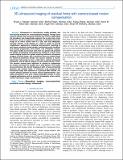3D Ultrasound Imaging of Residual Limbs With Camera-Based Motion Compensation
Author(s)
Ranger, Bryan J.; Feigin, Micha; Zhang, Xiang; Moerman, Kevin M.; Herr, Hugh M.; Anthony, Brian W.; ... Show more Show less
DownloadAccepted version (5.008Mb)
Terms of use
Metadata
Show full item recordAbstract
Ultrasound is a cost-effective, readily available, and non-ionizing modality for musculoskeletal imaging. Though some research groups have pursued methods that involve submerging the transducer and imaged body segment into a water bath, many limitations remain in regards to acquiring an unloaded volumetric image of an entire human limb in a fast, safe, and adequately accurate manner. A 3D dataset of a limb is useful in several rehabilitative applications including biomechanical modeling of soft tissue, prosthetic socket design, monitoring muscle condition and disease progression, bone health, and orthopedic surgery. This paper builds on previous work from our group and presents the design, prototyping, and preliminary testing of a novel multi-modal imaging system for rapidly acquiring volumetric ultrasound imagery of human limbs, with a particular focus on residual limbs for improved prosthesis design. Our system employs a mechanized water tank setup to scan a limb with a clinical ultrasound transducer and 3D optical imagery to track motion during a scan. The iterative closest point algorithm is utilized to compensate for motion and stitch the images into a final dataset. The results show preliminary 2D and 3D imaging of both a tissue-mimicking phantom and residual limbs. A volumetric error compares the ultrasound image data obtained to a previous MRI method. The results indicate potential for future clinical implementation. Concepts presented in this paper could reasonably transfer to other imaging applications such as acoustic tomography, where motion artifact may distort image reconstruction. ©2019
Date issued
2019-02Department
Massachusetts Institute of Technology. Institute for Medical Engineering & Science; Massachusetts Institute of Technology. Media LaboratoryJournal
IEEE Transactions on Neural Systems and Rehabilitation Engineering
Publisher
Institute of Electrical and Electronics Engineers (IEEE)
Citation
Ranger, Bryan J., et al., "3D Ultrasound Imaging of Residual Limbs With Camera-Based Motion Compensation." IEEE Transactions on Neural Systems and Rehabilitation Engineering 27, 2 (February 2019): p. 207-17 doi 10.1109/TNSRE.2019.2894159 ©2019 Author(s)
Version: Author's final manuscript
ISSN
1534-4320
1558-0210